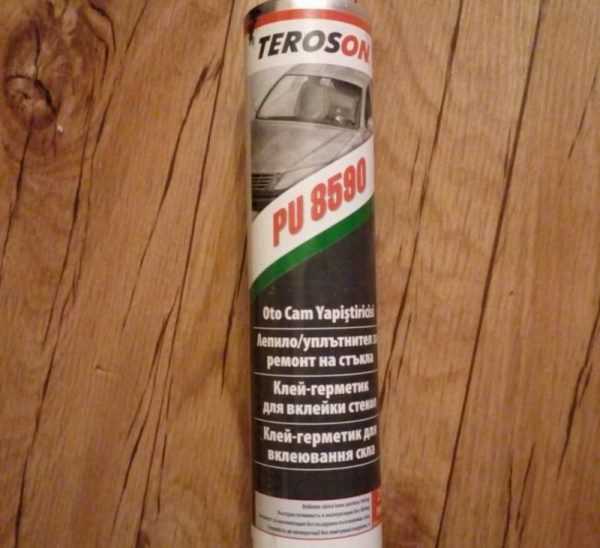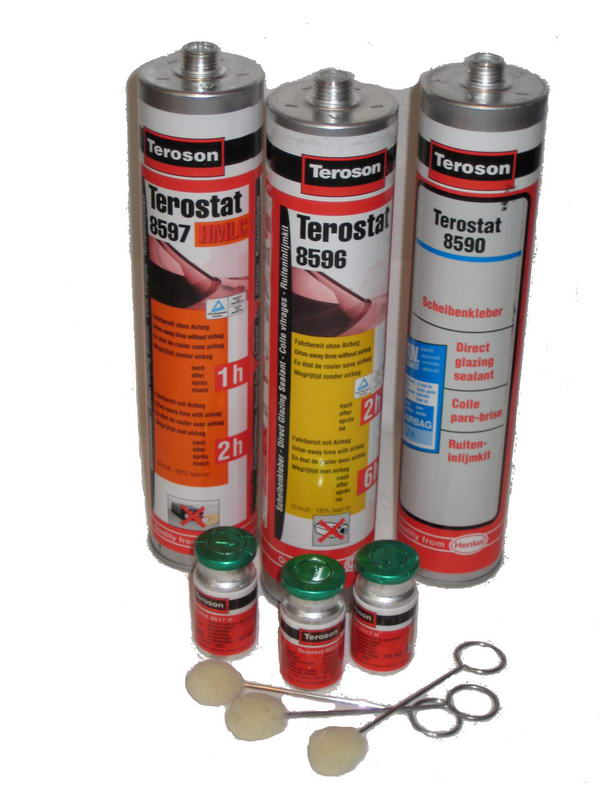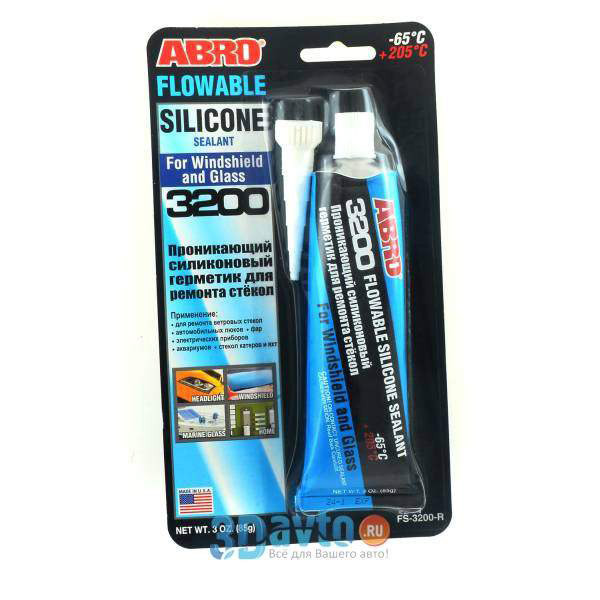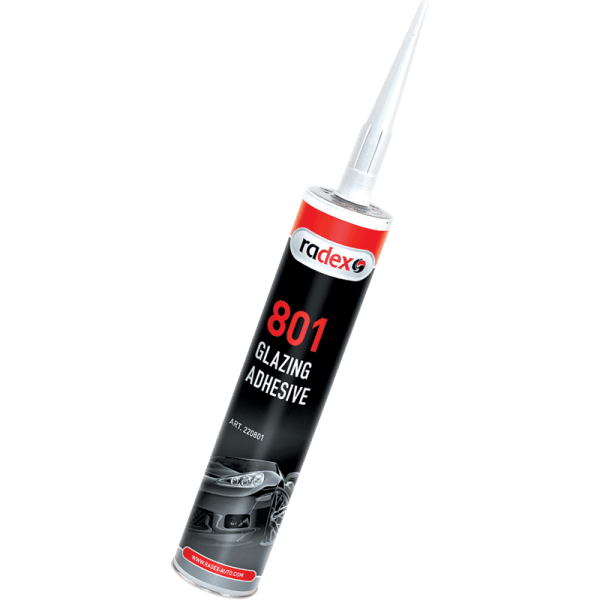Adhesive requirements
The car is constantly in motion, it is affected by temperature extremes, vibration and adverse weather conditions, therefore, the adhesive sealant for gluing glass must have:
- resistance to temperature extremes;
- good adhesion to various materials;
- high elasticity and lack of shrinkage;
- vibration resistance;
- moisture repellency;
- high drying speed;
- the ability to apply at any time of the year, even at low temperatures;
- environmental friendliness;
- durability;
- the possibility of tinting (in some cases, a car requires not only gluing glass, but also matching the color of the sealant to the color of the car body).
A polyurethane sealant adhesive for gluing glass and replacing or repairing headlights is considered the most suitable among auto repairmen for these purposes. Among the many polyurethane sealants used for glass replacement in cars, Henkel's Teroson is the most commonly used.
How to use adhesive sealant
A firmly fixed windshield is no less important for the safety of the driver and passenger than belts, airbags and other passive safety devices, therefore, the car glass must be glued in compliance with all technologies. There are many polyurethane adhesives, so let's look at the technology for Henkel's most popular Teroson adhesive sealant:
There are many polyurethane adhesives, so let's look at the technology for Henkel's most popular Teroson adhesive sealant:
Material preparation. Most adhesives and sealants, including Teroson, need to be warmed up before application. For this, the tubes with glue are placed in a special heater. While the adhesive is warming up, you can dismantle the car windshield or carry out other preparatory work.
Dismantling glass. To do this, on most cars, it is necessary to remove additional decorative elements, and then, using a stretched wire or special knives, carefully cut the seam from the old sealant. After cutting the seam, the windshield or rear window is carefully removed.
Surface cleaning. New glass in the places where the glue is applied is thoroughly cleaned. It is recommended to buy cleaners from the same company as the glass sealant.
Body preparation. To do this, it is cleaned of dust, dirt and remnants of old sealant, the damaged body coating is restored
It is important to restore the paintwork before the glass is bonded. All preparatory work is carried out before installing the glass.
Glue application
The windshield sealant adhesive is gently applied either to the glass itself or to the car body. The choice of the method does not affect the quality of the replacement and depends only on the preferences of the master. The glue is applied so that the glue roll is the same everywhere.
Installation of glass. This must be done immediately after uniform application of the sealant, because it has a high solidification rate. If you install the glass after a short period of time, then due to the viscosity of the glue, it will not adhere well, and the tightness of the joints will be broken.
Polymerization of the sealant. After the glass has been installed, it is necessary for the seams to polymerize, and this time the car must be stationary - 1 hour if there are no airbags in the car, and 2 hours if there are airbags.
After that, the car can be used without restrictions, but in the next couple of hours it is not recommended to reach a speed of over 60 km / h.
Headlight repair is carried out according to a more simplified scheme:
- The place where the sealant will be applied is cleaned of dirt.
- After cleaning from dirt, the edges are treated with a cleaner.
- Glue is applied to the glass in an even layer.
- The headlamp is glued into place immediately after applying the sealant to the glass.
As with installing glass, after repairing the headlight, you need to wait an hour. If you start moving immediately, then the vibration that occurs when the car is moving will disrupt the polymerization of the sealant, and the seam will be fragile, and soon the headlight will need additional repair.
If you choose the right glass glue, taking into account all the required characteristics, and use it as recommended by the manufacturers, then the installed windshield or rear window will hold firmly for a long time.
How to protect your windshield
To prevent chipping, there is a special film that is glued from the outside to the entire surface of the glass. It will protect you from minor damage, but won't save you from major damage. And this film has a very significant drawback. It is quickly overwritten with wiper blades. Our roads are still not clean enough and the dirt on the cars makes it impossible to doubt this. It even leaves arched stains on the glass. What can I say about the film? There is only one recommendation - accuracy in driving. Do not come close to the car before overtaking, but start maneuvering at a distance. On a gravel road, disperse with oncoming traffic passing closer to your side. And stay away from the gravel trucks ...
Varieties
When you are convinced of the very fact of the existence of miraculous adhesives for glass, it remains to classify them by type. Depending on the composition, there are silicone, polyurethane, epoxy and polymer sealants. By the amount of reagents - one- and two-component. There can also be adhesives for fastening and optical, restoring the damaged area, masking the appearance of the flaw on the glass.
By appointment
Depending on their purpose, sealing adhesives are divided into assembly (for installing new glass) and repair. It is advisable to avoid attempts by sellers and consultants to impose universal sealants.
The subtlety lies in the fact that the glass structure provides not only visibility, but also the overall rigidity of the car, being an important part of the frame. Poorly, poorly repaired glass will not be able to perform this function
Mounting compound for gluing
Such familiar, soft and elastic bands, which reliably fix the glass plane in the frame, absorb vibrations transmitted from the suspension, are a thing of the past. Instead, an on-site sealant layer based on polyurethane or silicone is used.
More often than others, masters use the compositions of DOW, 3M, Sika, Wurth, Teroson, Eftec sealants for gluing. A couple of hours will pass, and the sealant will harden, fixing the plane of the car glass, ensuring reliable contact with the body.

Optical or repair sealant
The next group of compositions is for repair or optical. Dealing with them is easy: you need to get rid of chips, seal the crack on the glass - opt for an optical sealant. To form a glass seam bead that holds the window plane, another composition is needed - an assembly one. These adhesives are not interchangeable as they serve different purposes. Their setting speed is not necessarily the same.
For optical silicone, it is important that after polymerization it will not become cloudy, will not lose transparency, and will not be conspicuous. Otherwise, the repair makes no sense, then it is easier to change the glass
At the service of rewindrs - compositions of the brands Henkel, 3M, Dow, sealants from other manufacturers.
By composition
The basis of modern miracle adhesives is polymers. Polyurethane, silicone, acrylic compounds with ultraviolet stabilization - this is an approximate list of sealants offered by automakers. They also differ in the degree of adhesion, the depth of penetration into the glass, and the curing time of the glue.
Balm
The main component of this glue is fir resin, sap.Suitable for gluing glasses, fixing fragments together. The sealant has a slight yellowish tint.

Balsam
A variation of the previous composition, with a more pronounced yellowness of the hardened vitreous mass. Differs in increased adhesion, reliability. Despite the quality characteristics of the sealant, glue is rarely used due to its low transparency.
Balsamin-M
Modifier on natural ingredients with improved transparency. The composition retains the advantages of balsam: elasticity of the joint, work in a wide temperature range, transparency of the glue.
UV
For stabilization, setting of this composition, a source of ultraviolet radiation is certainly needed. After polymerization, the sealant is transparent, durable and reliable.
Acrylic based
With the discovery of acrylic resins, they quickly found use in a variety of applications, including automotive glass repair. There are no complaints about the characteristics of the resulting glue roll, except for a slow, "thoughtful" setting. On average, acrylic sealants will cure in 2-3 days.

Silicone
Viscous composition with a characteristic vinegar odor. Used in plumbing, construction, renovation. Also suitable for gluing glass. It sets quickly, the seam is moderately elastic, the glue does not lose its properties over time.
Polyurethane based
Polyurethane, rubber-like sealants are a serious competitor to silicone. They form a liquid-resistant, durable and elastic adhesive layer. They are not afraid of heat and cold, easy to work with.
Polymeric
According to their characteristics, polymer adhesives are close to silicones and polyurethanes, but after hardening, it is difficult to remove excess composition without special solvents. Sealants are characterized by increased adhesion, are resistant to chemicals, and can be stained.

The better to glue the headlamp glass: types of sealants
The market offers quite extensive
assortment of formulations differing in chemical properties, convenience
application, cost. What to choose? First you need to deal with
classification. There are 4 types of sealants
for headlights and car glass.
For better adhesion, it is better to dismantle the headlight.
Silicone
In terms of composition before polymerization, it is
semi-liquid fluids made from natural or
artificial rubber. After application, the material hardens, turning into a kind of rubber that glues
surface, protects against UV radiation and seals the joints. But silicone products have significant
minus - weak resistance to chemically aggressive environments, for example,
technical oil, gasoline, diesel fuel, etc.
This is especially important if the car has a headlight washer system, in
which uses a special fluid that makes its own "mite" in the process
destruction of the sealant, but sometimes oil-resistant agents are found. In winter on
it is also affected by anti-ice reagents
The main plus of silicone
compositions - low cost and the ability not to lose their qualities in a wide
temperature range - up to + 100 ° С. Ideal for installing fog lamp glasses.
Polyurethane
These car
sealants help well in situations where it is necessary to glue individual fragments
broken glass of the headlight or just repair a chip, crack. The main advantage of polyurethane compounds is high
adhesion (stickiness) and good adhesive properties. Cured sealant based
polyurethane - waterproof.
There are other advantages as well:
- use adhesive
possible in a wide temperature range - from minus 60 to plus 80 ° С; - the operational period reaches several years;
- the composition is resistant to the effects of engine oil, fuel,
alcohol washer fluid and anti-ice reagents; - good fluidity before polymerization makes it possible to connect fragments
the most complex configuration; - frost resistance;
- glued construction
confidently resists vibration.
Polyurethane sealant: everything is written on the packaging
What about the downsides? They too
are available. The first is toxicity, which implies adherence to specific rules.
safety: you need to work in rubber gloves, glasses, and sometimes
respirator (if the amount of work is large, for example, in an automatic machine shop). And one more
minus - poor resistance to high (more than + 120 ° C) temperatures, which
characteristic of halogen lamps. However, the tool is quite suitable for repairing mirrors.
Anaerobic
These compositions are characterized by high
strength and resistance to high temperatures (up to + 200 ° C). Sealants of this
type used for sealing joints, seams. Anaerobic sealants before polymerization
are in liquid form. Because of
this causes some inconvenience during use. But chemical
the composition of the product is harmless to humans, and additional protection in the form of gloves
and glasses are not required. The only requirement is to avoid hitting
sealant in the mouth and eyes.
Heat resistant (high temperature)
The main advantage of these sealants for headlights and car glass is
from their name. Compositions of this type can freely withstand temperatures up to +300 and
even + 400 ° C. That is, these thermosealants are good
suitable for work with headlamp lenses with halogen lamps. The heat-resistant agent is quite
durable, not afraid of vibration and mechanical stress. Release
heat-resistant sealants in the form of a paste or two-component form. There are
lack of high-temperature auto-sealant -
long solidification time, up to 8-12 hours.
Windshield gluing rules
The whole procedure fits into several interrelated stages. The final result depends on adherence to consistency and accuracy. So this:
- Removing old glass. At the same time, seals, decorative inserts are removed. A sharp knife or piece of wire is used and inserted into the seam.
- Next, the contact areas of the new window panel are cleaned, the mating units of the body. If damage to the paint and varnish layer is found, they are restored.
- If, according to the technology, the glue is applied at a certain temperature, this condition must be met.
- It remains to carefully distribute the glue (create a roller) on the glass or in the body recess, and then glue the glass onto the composition.

Removing old sealant
The old seal is removed mechanically using a sharp knife. Then the surfaces are cleaned of dust, dirt, degreased, prepared for glass installation
It is very important that there are no fragments left, otherwise obtaining a high-quality adhesive seam is not guaranteed.
How much dries
The setting time of the glue depends on the specific brand of the composition, the version of the car (with or without pillows), layer thickness, temperature. For modern polyurethane sealants, the average polymerization time is 10-15 minutes, and the adhesive gains strength within an hour. For comparison: acrylic mixtures dry up to 3 days.
Terms of use
It is important to apply any sealant at a positive air temperature; most manufacturers advise that the temperature be above +5 degrees, or better, more than +15 degrees. After about 2-3 hours, the car must not be moved
It is important to wear rubber gloves and safety goggles before starting work.
Sometimes old sealant is difficult to remove. At first, it can be heated with a construction hairdryer, thanks to which the old product will soften and be easier to remove from the surface of the car.
Remains of the substance can be removed with a regular knife, however it is important to cut the sealant carefully so as not to leave scratches on the car body. To dissolve the remains of the sealant, use a solvent or solarium. It is necessary to adhere to the following sequence of actions when gluing glass:
It is necessary to adhere to the following sequence of actions when gluing glass:
the old seal can not be completely removed, but cut with a sharp knife to a thickness of about 2 millimeters;
if required according to the instructions, the substance must first be warmed up before application;
the sealing compound is applied using a pneumatic or mechanical pistol, in a uniform layer without breaks;
after gluing the glass, it is important to fix it with ordinary masking tape;
the side windows of the car are lowered to dry and ventilate the car.
It is important to remember that any sealant can only be applied to a surface that has been previously cleaned of dust, dirt, debris, grease stains and other contaminants. The surface must be degreased with a solvent
Until the composition has completely solidified, you must not slam the car doors. It is not recommended to drive the car for the first 48 hours after pasting the glass.
Varieties and features
The main task of sealants is considered to be the elimination of leaks and cracks. With their help, it is possible to cope with punctures and gaps. There are many such products on sale. At the same time, their purchase should be treated very carefully. To buy a quality substance, it is recommended that you familiarize yourself with its characteristics and composition.
Anaerobic
Such sealants are special compounds containing dimethacrylate esters. They are characterized by the possibility of polymerization without an influx of oxygen. Substances acquire a solid consistency when in contact with metal in narrow places where air does not penetrate. If these conditions are violated, the product will remain in liquid form.
To achieve polymerization of the composition, it is worth tightly connecting the elements of the parts. This will help remove oxygen. When it gets into a metal gap, the substance solidifies within half an hour, becoming a solid polymer.
Silicone
For independent use, it is worth using a silicone sealant. The composition is characterized by excellent elasticity and high strength. Such substances differ in terms of elasticity and temperature. Sealants polymerize due to moisture in the air.
Polyurethane
This sealant promotes adhesion of different structures. The substance is characterized by excellent adhesion. It is produced in different colors. This helps in choosing the right formulation.
For exhaust system repair
This system is susceptible to high temperatures. The maximum load is on the muffler. Under the influence of negative factors, the elements of the system are destroyed and burned out.
To repair the exhaust system, you should use a heat-resistant sealant. Its use will help to avoid sticking pipes and clamps to each other. In this case, the sealing of the joints will be as reliable as possible. Compositions in the form of cement, glue or paste can be used for rounded elements of the exhaust system.
Acrylic
Such sealants are a mixture of acrylate polymers that are used for interior work. They are often coated with acrylics or varnishes. Due to this, it is possible to obtain different shades. Such formulations are waterproof and non-waterproof.
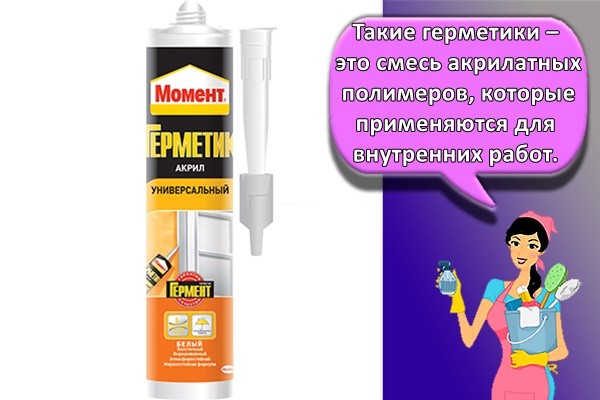
Bituminous mixtures
This term is understood as a pasty substance, which is made on the basis of a modified material with the addition of fillers. Thanks to this, the product acquires resistance to negative factors.
Ceramic
Such products are made on the basis of synthetic components using ceramic components. Due to this, it is possible to increase the strength and resistance of the material to high temperatures.
For glass and headlights
When choosing a sealant, you should focus on the recommendations that are given in the service book
Of no small importance is the material from which the headlights are made. For this, glass or polycarbonate is used.
Many compounds are forbidden to be used for repairing polycarbonate, as they lead to its destruction. The shade of the adhesive has no effect on its properties.
Chipped repair
In a repair shop, a thin drill with a cutter at the end passes the place of the chip, trying not to go deep into the film between the triplex glasses. The hole makes it easier for the glue to fill the cavities. Using an injector, pressure and vacuum are created for high-quality flow of the polymer. Then polymerization or drying takes place under the lamp. The remnants of the glue are cut off with a special soft blade so as not to scratch the glass.
The glass being repaired dries as long as it takes for each type of damage. If the chip is small, then ten minutes is enough, and with complex repairs, the drying time of the glue can take up to half an hour.
It is necessary to seal the damage with transparent tape from the outside. This will not give dirt access, and will postpone the visit to the master a little. And if the chip is closer than 15 centimeters from the edge, then you need to look for the nearest repair service. Otherwise, it will develop into a crack due to the stresses of the glued glass, arising from the torsion of the body.
Types of glue for car glass
It is possible to correct the defect without resorting to the services of auto repair shops for glass replacement. You can glue the crack on the windshield with your own hands. For this, organic resins and synthetic polymer components are used.
Glue for auto repair is used: to fix and install the entire front glass or to eliminate chips and cracks on it. In the first case, a flexible connection is created, which makes it possible to compensate for deformation vibrations. The composition must meet the following requirements:
- Thermal and moisture resistance.
- Create an airtight coating.
- Form a seam that is resistant to prolonged vibration and aggressive environments (wipers, icing, intense pollution).
- Average setting speed.
- Low viscosity (to penetrate micro-chips).
- Transparency.
To eliminate cracks and chips, the following compositions are suitable:
- Glass balm: "Canadian balm". It is a solid transparent material that is composed of organic resin. Firmly holds the fragments together and does not crystallize. Heating is required to use it. Time to complete drying 48 hours.
- Silicone glue: Done Deal DD6705. Synthetic compound with high adhesive properties. Has a wide operating temperature range. Provides reliable fastening of materials.
- Acrylic adhesive: Master Teks. Suitable for repairing cracks and sealing chips. Creates a flexible layer after drying.
- UV adhesive: UV SM 510. The joint is not damaged even if the glass is broken. For activation and setting, exposure to a UV lamp is required.
If it is not possible to instantly seal the damage, use scotch tape. This will keep the split from spreading for a while.
Which sealant is better
When choosing a product, you should pay attention not only to its parameters, but also to the popularity of the brand: it is not recommended to buy the cheapest, untested formulations
SikaTack Drive
A distinctive characteristic of the sealant is its suitability for any glass of trucks and cars. The product is available in 310 ml tubes, is used without preheating at temperatures around + 20 ... + 22 degrees, hardens in 4 hours.

3M Windo Weld SuperFast Urethane
The sealant does not require the use of a primer, since it is itself quite durable and is not afraid of ultraviolet radiation. It can even be used on the glass of racing cars and off-road vehicles. After application, the product begins to set in 15 minutes, complete crystallization occurs in 8 hours.

Dow Automotive Betaseal 1527
The set of devices for making a sealing seam includes a primer - it is mandatory for use with this composition. The tool has the following properties:
- low electrical conductivity;
- initial setting in 12 minutes;
- highest strength;
- suitability for all types of transport;
- the ability to apply at +5 degrees and above.

After gluing the glasses, you can use the machine after an hour (in emergency situations), so the product is considered one of the fastest-drying glass adhesives.
Dow Corning 7091
This silicone-based composition is widely used when replacing glasses, since it has excellent adhesion to metal, plastic, is characterized by high elasticity, strength, works at -55 ... + 185 degrees. Usually, a white sealant is used for glass installation, although there are also black, gray products on sale.
The composition of this brand is available in a standard 310 ml tube, as well as in cans of 20 liters and 250 kg (for industrial use). It hardens in 3 hours; when applied, it does not require priming or heating.

3M PU 590
The tool is considered universal, suitable for working with a variety of surfaces - glass, metal, wood, plastics. It sets in 25 minutes, dries completely in 4-8 hours, does not require the use of a primer. The disadvantages include the risk of cracks and crumbling when heated above +100 degrees.

Abro WS 904
A sealant with this name is highly regarded by professionals and is considered one of the leaders in the market. It is realized in the form of a tape twisted by a roll, is easy to use, does not stick to hands, has a high degree of adhesion and plasticity.

Donedeal DD6870
The product has a high degree of transparency, is invisible on glass, and can be used to repair other car parts. The characteristics of the sealant are as follows:
- operating temperature - from +5 to +30 degrees, operating temperature range –45… + 105 degrees;
- bond strength - 195 kg / sq. cm;
- initial setting time - 1 hour, period until complete polymerization - 24 hours.

The sealant is well suited for bonding materials with different coefficients of thermal expansion - plastic, glass, plexiglass, rubber, metal. It does not deteriorate from vibration, mechanical stress and the action of chemicals.
"Efimastika RV"
One-component polyurethane sealant is used in conjunction with the primer that comes with the kit. It forms a very strong bond between glass and metal, plastic, completely solidifies within 24 hours, although it forms the initial film in 30 minutes. The seam can be operated at temperatures from –40 to +80 degrees, has a high tensile strength (6 MPa).

Teroson PU 8590
This sealant is also prepared on the basis of polyurethane, it is widely used for gluing auto glass not only in passenger cars, but also in trucks, buses, and railway cars. Requires prior application of a primer. Grabs in half an hour, dries in 4-6 hours. It is UV-resistant, wear-resistant, holds the glass securely immediately after insertion.

Merbenit SK212
The product based on modern MS-polymers boasts the highest tensile strength, it is even used in shipbuilding. The sealant does not need a primer, heating, it is resistant to vibration, stress, ultraviolet light, protects metal from corrosion, and can be painted even in a semi-frozen form.

Liqui Moly Liqui Fast 1400
Polyurethane sealant of this brand is used for gluing any glass of a car, it cures in a short time under the influence of moisture. Has good elasticity, elasticity, strength.
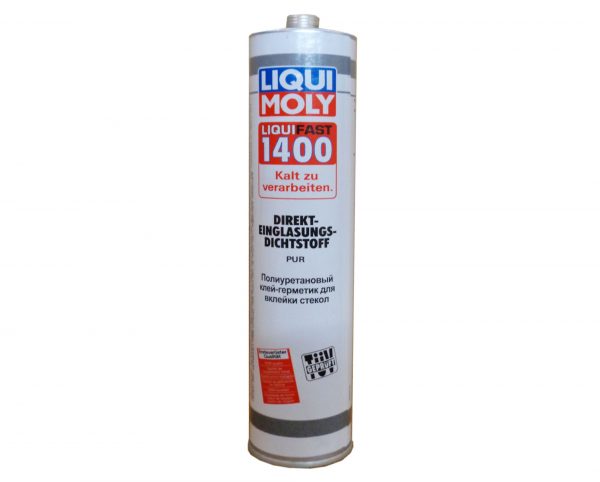
Types of body sealants by application method
Today there are many varieties of sealants that differ in the method of application.
Sprayable moisture cure
Typically, these include modern polymers. The compositions are made one-component. There are many dry components in substances, therefore they dry quickly in air under the influence of humidity. As a result, a strong seam is formed. A special gun is used to apply sprayable sealants.
Brush application
Such funds are made from silicone and nitro-rubber. They are used for sealing seams, fixing lintels, pallets, sealing the trunk and wheel arches. Compositions are produced in white, gray or black. It is recommended to apply them with a brush. Drying takes 10 minutes.

Sealant tape
Applying a substance to a machine often requires special skills. Otherwise, it will not be possible to make the seam durable. If there is no skill, use tape. Such a sealant does not need to be glued. The material is flexible, which helps to make repairs in different places. It is permissible to paint the tape immediately after fixing. You do not need to dry it.
Extruded
Such substances are sold in tubes or cartridges. For sealing seams and joints, it is recommended to squeeze out the substance by hand or use a gun. When using a pneumatic gun, a uniform seam will be obtained. Such formulations are suitable for bonnet seams.
How to glue a windshield using a sealant - technology
Stage 1 - cutting the windshield
The work must be done together. The first thing to do is to pierce a layer of polyurethane adhesive between the glass and the body. This will allow you to quickly and easily cut the glass with a string. We pierce the glue with an awl with a stretched string, the awl goes through the glue. Using the pliers, we pry the string from the back side so that it passes through, after which we pull out the awl back. As a result, one end of the string remained in the cabin, and the other outside.
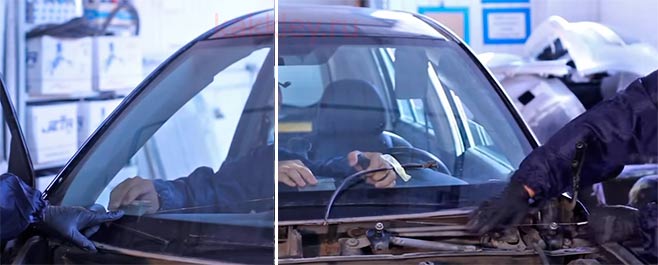
We attach the string to the handle, for which we will pull it.
Stage 2 - cutting glass
It is important not to scratch the torpedo and plastic parts of the car body while cutting. The string works like a knife
We gently pull the string along the glass, the assistant helps to pull the string while in the cabin. In the corner, we wind the string up and continue cutting along the side of the glass, then go to the top and return to the starting point.
We take out the cut glass and remove the remaining glue, leaving about 1 mm. This is how we prepare the area for applying new glue.
Stage 3 - glass preparation
We fix special Velcro on the left side of the windshield, for which we will lift and move it. To make the Velcro stick tight, grease the back side with greasy soap. We repeat the procedure on the right side of the glass.

We glue the masking tape near the gluing point. We clean the area with a solvent.
Stage 3 - applying glue
To apply glue, we use a special gun for working with glues in foil film. It is best to purchase a pneumatic model. The convenience of such a pistol lies in the simplicity and reliability of the design and the ease of applying the composition. To start the gun, you just need to pull the trigger. Using this device, you can gently apply glue in an even, continuous layer around the entire perimeter of the glass.
If we use Simp Seal 65 glue, we cut the nose of the tube with a knife. This is necessary in order for the glue to form a "triangle". Then we make an incision in the foil with glue, insert the package into an air gun. Install the notched nose, tighten the pistol nut. Now you can start applying the glue. Gently squeeze it out of the pistol and move around the entire perimeter of the glass. To make it convenient to work, the glass can be placed on the hood of the car.
 Sealant application and windshield fixing
Sealant application and windshield fixing
Stage 4 - glass installation
We lift the glass with the Velcro and install it back into the car. We secure it on top with additional tape to prevent slipping. We leave the car to stand for glue polymerization for at least 1-3 hours. Then the car can be rolled out into the parking lot and left for a while. The car can be used the next day.
VIDEO INSTRUCTION
How to change glass
A quick guide will help you understand the basic process of replacing a windshield on any car, they are almost the same.
Tool
- Suction cups for the front stack - 2 pcs.
- Adhesive sealant and spray gun for application.
- Stationery knife.
- Degreaser.
- Help from a second person.
How to change
 By following simple steps, you can perform such a seemingly difficult task as replacing the windshield. After preparing everything you need, get to work.
By following simple steps, you can perform such a seemingly difficult task as replacing the windshield. After preparing everything you need, get to work.
- The first thing to do is to remove all the decorative elements (wipers, plastic hood grilles).
- Remove the moldings (rubber between glass and body metal).
- We remove the plastic linings from the inside of the passenger compartment (side linings).
- Next, you will need a special tool - a string (a metal thread looks like a plow from a guitar). It must be passed between the glass and the car body. This is done with the help of another tool - an awl (visually similar to a knife with a serif for a string).
- Now the string (which has handles on each side) needs to go through the entire perimeter of the glass. It looks like a "cut" in glue. This job requires two people. One in the cabin, the other outside.
- After cutting through the old sealant, the windshield can be safely removed.
- We remove the old sealant with a clerical knife.
- We put on the molding on the new glass before installation.
- We degrease the car body and glass. Those places where we wake up to apply glue. If the “activator” is included with the glue, it must be applied to the glass surface with a thin and even layer. Drying time of the sealant activator is 1-2 minutes.
- We apply glue-sealant to the degreased surface. It is applied using a special tool - a syringe. The layer should be even, high but thin. This will ensure maximum sealing and adhesive protrusion beyond the edges of the body edge. Some glue-sealant is applied to the glass, but sometimes it is applied to the car body.
- We apply glass to the car body. Responsible action. The glass should be firmly in place. For convenience, it is better to use glass suction cups.
- Slightly press the applied glass with the palm of your hand in the places of gluing (so that it fits clearly into the necessary grooves).
- In the reverse order, we proceed to the assembly of the decorative elements that we removed at the beginning.








